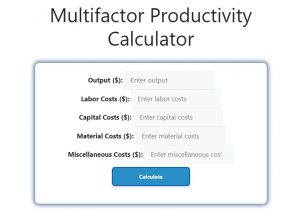About Multifactor Productivity Calculator (Formula)
The Multifactor Productivity (MFP) Calculator is a vital tool for businesses aiming to assess their overall efficiency by considering multiple inputs in the production process. Unlike traditional productivity measures that focus solely on labor, the MFP Calculator provides a comprehensive view by accounting for labor costs, capital costs, material costs, and miscellaneous costs. By analyzing these factors, companies can identify areas for improvement, enhance productivity, and make informed strategic decisions.
Formula
The formula for calculating multifactor productivity is:
Multifactor Productivity = Output / (Labor Costs + Capital Costs + Material Costs + Miscellaneous Costs)
This equation allows businesses to evaluate their productivity levels based on the total costs associated with production inputs.
How to Use
Using the Multifactor Productivity Calculator is straightforward. Follow these steps:
- Determine Output: Calculate the total output produced during a specific period. This could be measured in units, revenue, or any other relevant metric.
- Input Costs: Gather data on various costs:
- Labor Costs: Total expenses related to employee wages, benefits, and taxes.
- Capital Costs: Costs associated with machinery, equipment, and facilities.
- Material Costs: Expenses incurred for raw materials and supplies used in production.
- Miscellaneous Costs: Any other relevant costs not covered by the above categories.
- Enter Values: Input the values for output and each cost category into the calculator.
- Calculate: Click the calculate button to obtain the multifactor productivity result.
Example
Let’s say a company produced goods with the following details:
- Output: $500,000
- Labor Costs: $150,000
- Capital Costs: $100,000
- Material Costs: $75,000
- Miscellaneous Costs: $25,000
Using the formula:
Multifactor Productivity = Output / (Labor Costs + Capital Costs + Material Costs + Miscellaneous Costs)
= $500,000 / ($150,000 + $100,000 + $75,000 + $25,000)
= $500,000 / $350,000
= 1.43
In this example, the multifactor productivity is 1.43, indicating that for every dollar spent on inputs, the company generates $1.43 in output.

FAQs
- What is a Multifactor Productivity Calculator?
A Multifactor Productivity Calculator measures a company’s efficiency by evaluating output relative to multiple input costs. - Why is multifactor productivity important?
It provides a comprehensive assessment of efficiency, helping businesses identify strengths and areas for improvement. - What inputs does the calculator consider?
The calculator considers labor costs, capital costs, material costs, and miscellaneous costs. - How often should I calculate multifactor productivity?
It is advisable to calculate it regularly, such as quarterly or annually, to monitor performance trends. - Can I use the calculator for any industry?
Yes, the MFP Calculator is applicable across various industries, including manufacturing, services, and agriculture. - What does a multifactor productivity value greater than 1 indicate?
A value greater than 1 indicates that the output exceeds the combined costs of inputs, reflecting positive efficiency. - What if my multifactor productivity is less than 1?
A value less than 1 indicates that input costs are greater than output, signaling inefficiency and potential areas for improvement. - Can the calculator help with budgeting?
Yes, by analyzing productivity, businesses can make informed budgeting decisions to optimize resource allocation. - Is the MFP Calculator available online?
Yes, many online tools and software applications provide multifactor productivity calculations. - How can I improve my multifactor productivity?
Strategies include reducing costs, optimizing processes, enhancing employee training, and investing in technology. - What are some common pitfalls when calculating MFP?
Common pitfalls include inaccurate cost estimates, omitting relevant costs, and failing to account for changes in output. - Does the calculator consider external factors?
The calculator focuses on internal cost factors; external factors like market conditions may require separate analysis. - Can I compare MFP values across different companies?
Yes, but ensure that the comparisons involve similar industries and accounting practices for meaningful insights. - What role does technology play in improving MFP?
Technology can streamline operations, reduce costs, and enhance productivity, contributing to better MFP scores. - Is it necessary to input all cost categories?
While it’s best to include all relevant costs for accuracy, you can still calculate MFP with partial data. - How do labor costs impact multifactor productivity?
Labor costs directly affect input calculations; higher efficiency can lead to lower costs per unit of output. - What are miscellaneous costs?
Miscellaneous costs include any additional expenses not categorized under labor, capital, or material costs, such as utilities and maintenance. - Does the calculator provide historical comparisons?
Most calculators do not provide historical comparisons; however, you can track your MFP over time manually. - Can MFP values indicate business trends?
Yes, monitoring MFP over time can reveal trends in efficiency, helping businesses adapt their strategies accordingly. - How does MFP relate to overall business performance?
Higher multifactor productivity generally correlates with better financial performance, profitability, and competitiveness.
Conclusion
The Multifactor Productivity Calculator is a powerful tool for businesses seeking to evaluate and enhance their efficiency. By understanding the relationship between output and various input costs, companies can identify opportunities for improvement and make data-driven decisions. Regularly calculating multifactor productivity not only aids in optimizing operations but also contributes to long-term sustainability and profitability.